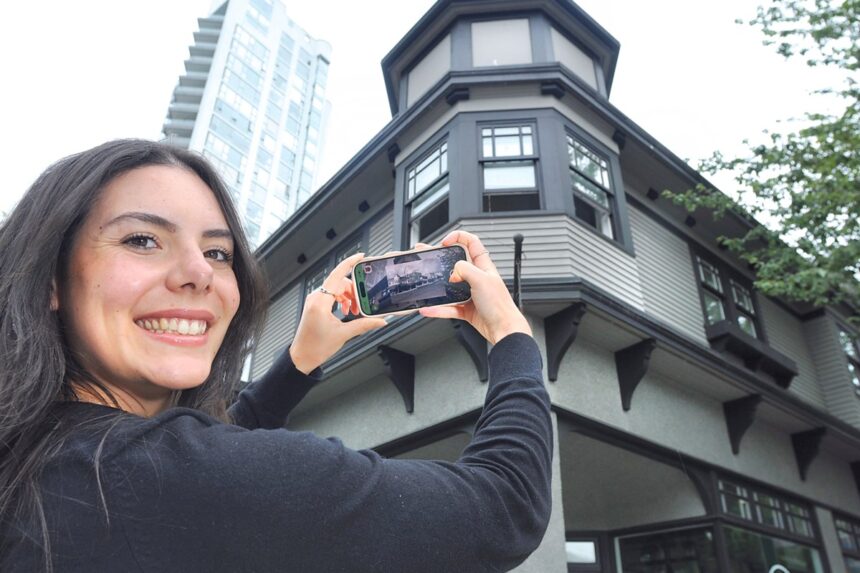I stood on a rain-drenched corner in Lower Lonsdale, phone in hand, as a black and white photograph materialized on my screen. Where I saw modern apartment buildings and the bustling Lonsdale Quay, my phone revealed the exact same location as it appeared in 1906 – wooden boardwalks, industrial buildings, and the foundations of what would become North Vancouver’s shipping and economic hub.
“It’s like a window through time,” explained Sheryl Rivers, a North Shore resident and Coast Salish artist who helped develop cultural content for the new North Shore Stories app. “For Indigenous people, this isn’t just about history – it’s about connecting present generations with places their ancestors have known for thousands of years.”
Launched last week through a collaboration between the North Vancouver Museum and Archives, West Vancouver Museum, and the Squamish and Tsleil-Waututh Nations, the free mobile application offers users a chance to experience the North Shore’s rich cultural tapestry through augmented reality, audio stories, and interactive maps.
The app arrives at a pivotal moment for the North Shore, where rapid development continues to transform neighborhoods while residents seek deeper connections to place. In a region where nearly 40% of residents were born outside Canada, according to Statistics Canada’s 2021 census data, the app serves both newcomers and long-time residents looking to understand the layers of history beneath their feet.
“We wanted to create something that wasn’t just educational but experiential,” said Victor Elderton, North Vancouver Museum director. “When people understand the stories of a place – whether it’s the Indigenous knowledge, the industrial history, or the artistic movements – they develop a different relationship with their community.”
What distinguishes this project from typical heritage initiatives is its collaborative approach. The Squamish and Tsleil-Waututh Nations weren’t merely consulted but actively led the development of content relating to their territories and cultural heritage. The result is a nuanced presentation that acknowledges colonial impacts while celebrating the continued presence and resilience of Indigenous communities.
Walking through Ambleside Park in West Vancouver, I activated another feature – an audio story narrated by Charlene Aleck, a Tsleil-Waututh Nation elder. She described how her grandparents harvested clams along these shores, the traditional food preservation techniques they used, and how industrial development eventually made the shellfish unsafe to eat.
“There’s something powerful about hearing these stories while standing in the exact locations where they took place,” says Dr. Emma Lowry, environmental historian at the University of British Columbia. “It creates an embodied understanding that reading a historical marker simply can’t provide.”
The technical development wasn’t without challenges. The app team worked with local tech company Overstory Digital to create an experience accessible to users across age groups. Early testing with seniors revealed navigation issues that required redesign, while balancing historical accuracy with engaging content presented another hurdle.
“We didn’t want to simplify complex histories, but we also needed something people could engage with during a 15-minute walk,” explained Jennifer Thatcher, the project’s technical lead. “That meant making careful decisions about which stories to feature and how to present them authentically.”
Beyond tourism potential, the app carries significant educational value. North Vancouver School District has already incorporated it into its social studies curriculum, with teacher-guided tours planned for the spring semester. According to research published in the Journal of Museum Education, place-based learning experiences can significantly improve student retention and engagement with local history.
The app’s content extends beyond pre-colonial and settler histories to include more recent cultural developments. Users can explore the homes where Group of Seven painter Frederick Varley created some of his most famous works, listen to the evolution of music venues along Marine Drive, or discover how the North Shore mountains influenced generations of filmmakers and outdoor enthusiasts.
For residents like Maya Donaldson, who moved to Lynn Valley three years ago, the app offered unexpected connections. “I had no idea my apartment building stands where a Japanese-Canadian family once operated a farm before being interned during World War II,” she said. “It completely changed how I see my neighborhood.”
The North Shore Stories app isn’t the first attempt to digitize local history, but its integration of diverse perspectives represents a significant evolution in how communities can approach collective storytelling. The Vancouver Heritage Foundation launched a similar initiative in 2018, though without the same level of Indigenous partnership or augmented reality features.
Funding for the project came through a combination of federal heritage grants, municipal support, and private donors, with free access considered essential to the project’s mission of accessibility. Project organizers are already planning content expansions, with seasonal updates that will highlight different aspects of North Shore heritage throughout the year.
As twilight fell over the Shipyards District, I watched families, tourists, and after-work crowds exploring with phones raised, pausing occasionally to listen or read. In a digital age often criticized for disconnecting us from place, this technology seemed to be doing the opposite – helping people slow down, look more closely, and recognize the many stories embedded in the landscape.
The North Shore Stories app is available for free download on iOS and Android devices.






